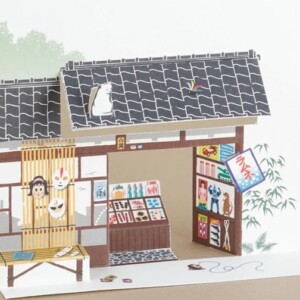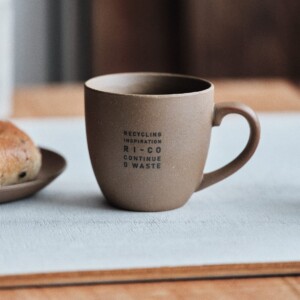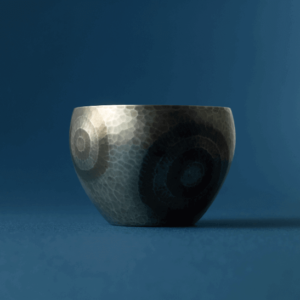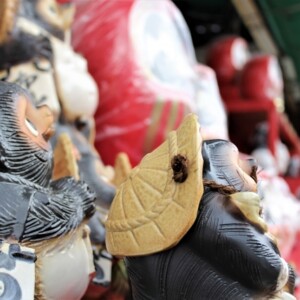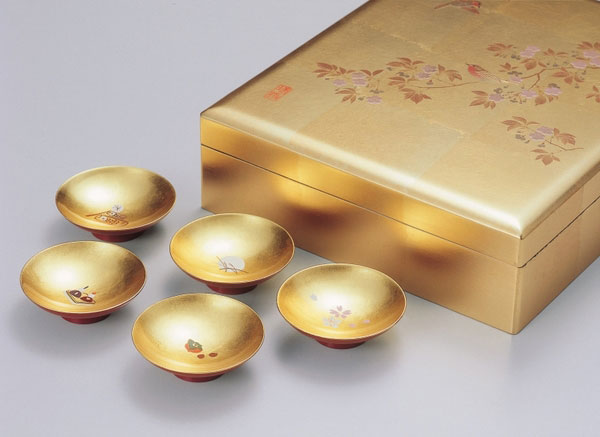
What is Kanazawa foil? Explaining the appeal based on its characteristics and history
Kanazawa Foil is one of the proud cultural industries of Kanazawa City, Ishikawa Prefecture.
Kanazawa foil, a gorgeous and gorgeous gold leaf, is the result of Kanazawa’s climate and characteristics.
In this article, we will explain the appeal of Kanazawa foil based on its characteristics and history.
Characteristics of Kanazawa leaf
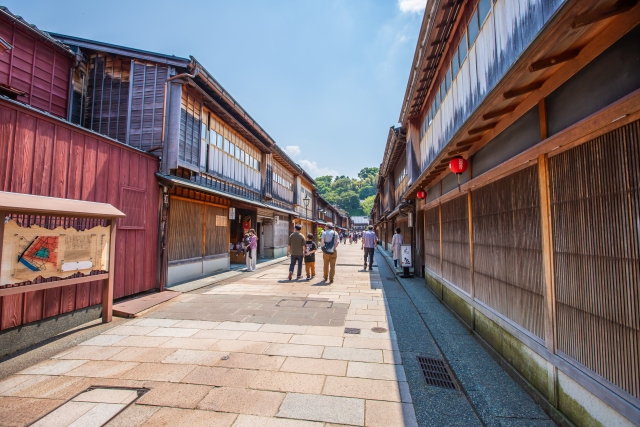
Kanazawa foil is a gold leaf produced in Kanazawa City, Ishikawa Prefecture.
It is said to have been produced as far back as the days of Maeda Toshiie, a warlord of the postwar period.
First, let us look at the characteristics of Kanazawa leaf.
Suitable environment for gold leaf production
Kanazawa City is located facing the Sea of Japan and is a humid area with a lot of rain and low sunshine rate.
Very thin gold leaf production tends to occur in dry areas, and Kanazawa’s high humidity is ideal for gold leaf production.
In addition, the Japanese paper used for “foiling,” the process of stretching gold, requires good quality water.
In Kanazawa, there are beautiful streams of water that support people’s daily lives, such as “Tatsumi Water Supply,” “Kurazuki Water Supply,” and “Onosho Water Supply.
It is because of this blessed environment that Kanazawa foil has become a culture to be proud of throughout the world.
More than 98% share of the national market
Today, Kanazawa foil boasts a 98% share of the national market, and 100% for silver foil and Western-style foil.
The reason for this can be attributed to the concealed foil stamping that was practiced in the Edo period (1603-1868).
At that time, the shogunate established an institution in Edo called “Hakuza” to control gold and silver foils.
The so-called “foiling prohibition ordinance” prohibited the production of gold leaf outside of Edo and Kyoto.
However, the Kaga Clan, which was Kanazawa at the time, continued to engage in “concealed foiling,” the manufacture of gold in hiding from the shogunate.
As a result, the technique of producing large quantities of high quality gold leaf using a small amount of materials was refined and is said to have been handed down to the present day.
The World of 1/10,000th of a Millimeter
The most attractive feature of Kanazawa leaf is its thinness of 1/10,000th of a millimeter.
The fact that the luster of the gold is not lost despite the thinness of the foil is a result of the long-accumulated skills of our craftsmen.
This thinness is what makes Kanazawa foil so attractive, as it can be applied to any material and easily used for delicate decorations.
Three characteristics
Kanazawa foil has three characteristics: it does not oxidize, does not discolor, and does not corrode.
While most metals are affected by air and water, gold, the raw material of gold leaf, is an extremely stable metal that does not rust or corrode.
Because of this ability to retain its beauty, Kanazawa foil is used for various furnishings and works of art, such as gold folding screens, lacquerware, and exteriors.
History of Kanazawa Foil
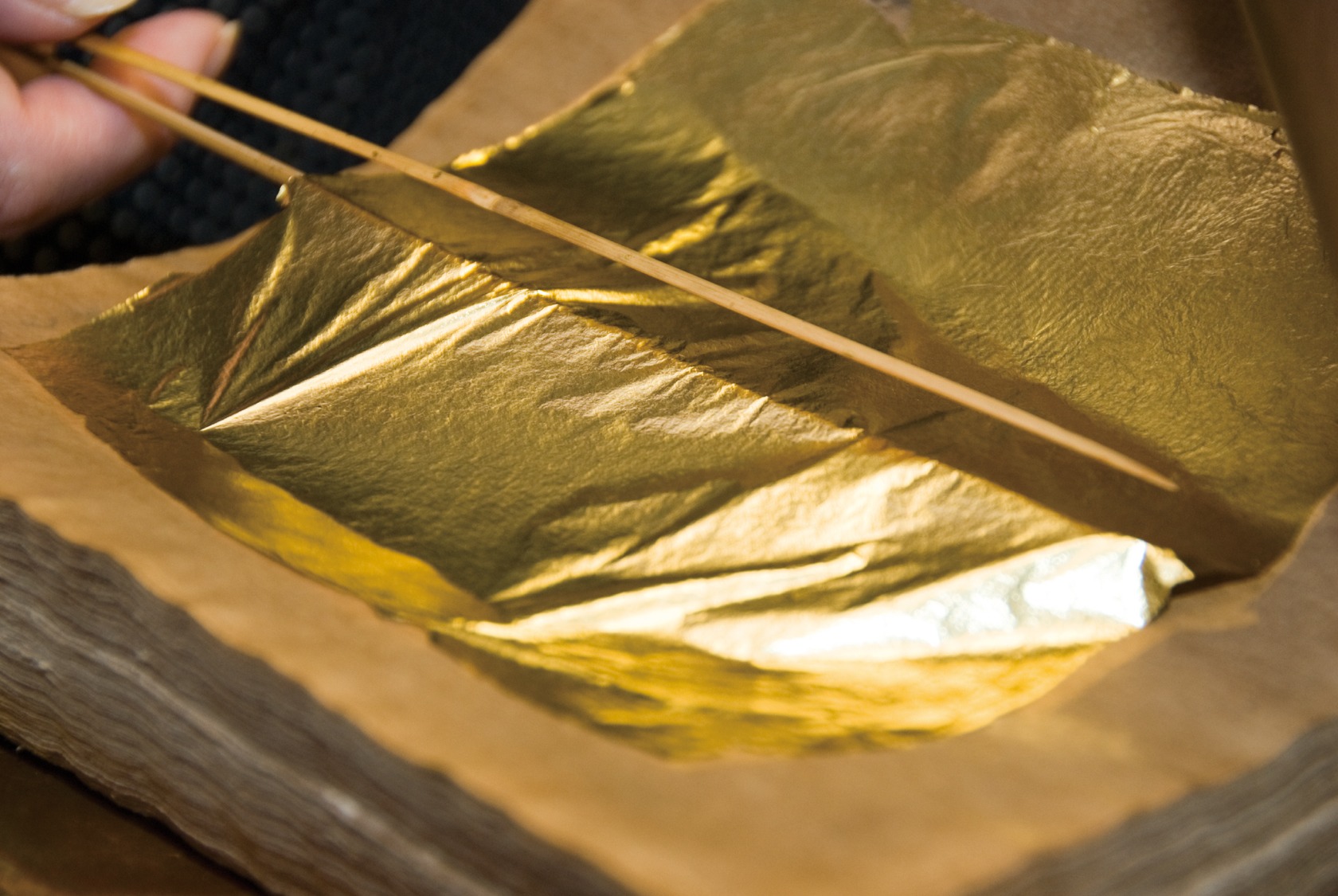
Kanazawa foil is a craft that has been manufactured for over 400 years.
The history of Kanazawa foil is explained next.
Late Warring States Period – Edo Period
The history of Kanazawa foil begins in the latter half of the Warring States Period.
At that time, Kanazawa was known as the Kaga domain and was ruled by Maeda Toshiie, the founder of the domain.
A document written by Maeda Toshiie in 1593 contains an order to produce foil, and it is believed that Kanazawa foil began to be manufactured around the same time.
However, in the Edo period (1603-1867), a “ban on foiling” was imposed and gold and silver foil could no longer be produced outside of Edo and Kyoto.
The Kaga Clan was no exception, but the art of foiling continued to be handed down in secret.
Craftsmen also worked hard to acquire rights, and in 1864, they were finally permitted to restore Kanazawa Castle and to produce foil only for official use.
From the Meiji Era to the Showa Era
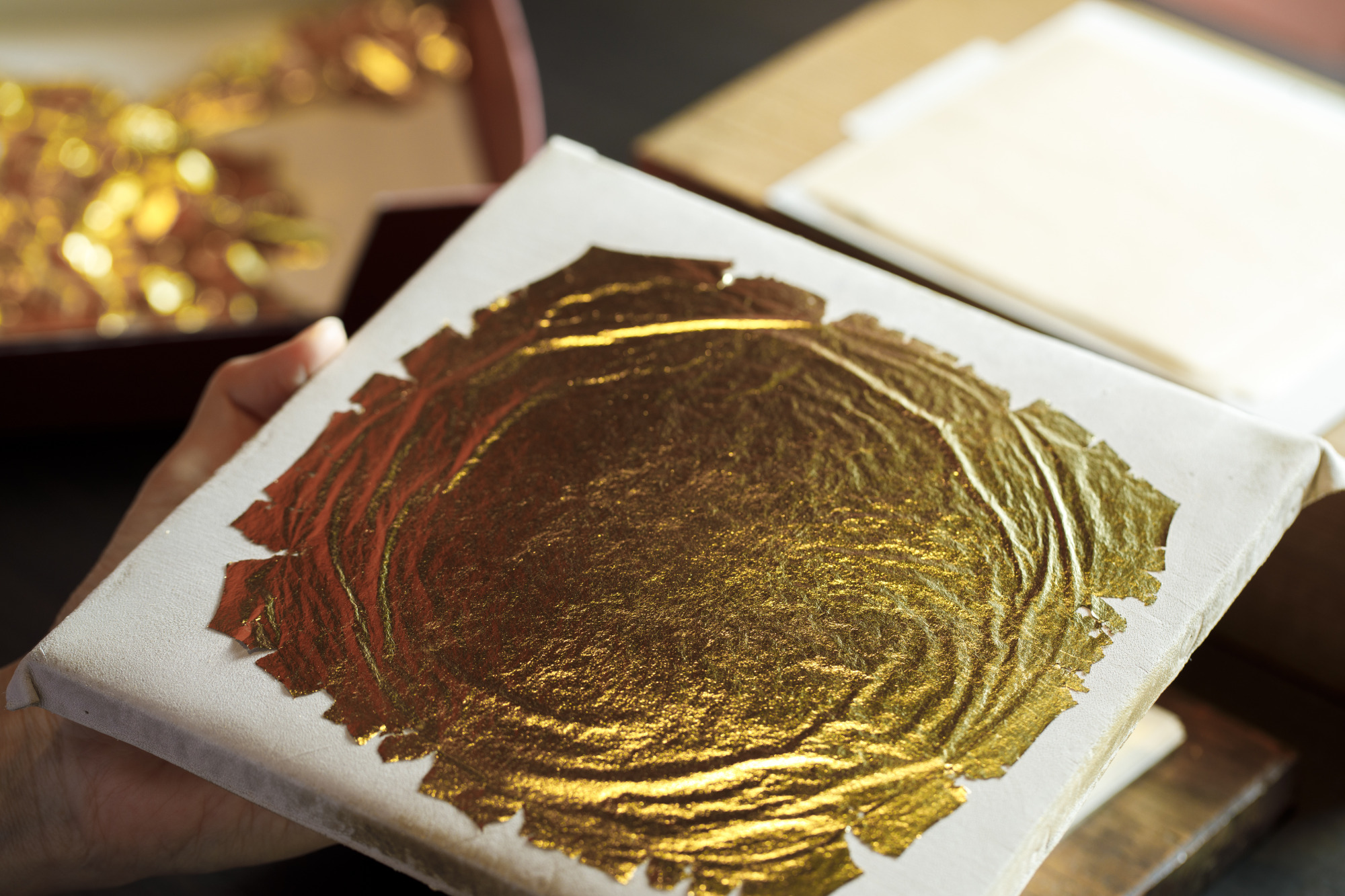
The long-standing ban on foil stamping was lifted in the Meiji era.
With this opportunity, Kanazawa foil gained momentum and began to evolve greatly as an industry in the region.
The development of foiling machines also contributed to a dramatic increase in the production efficiency of Kanazawa foil.
However, during World War II, restrictions were placed on the use of gold and the sale of anything other than daily necessities.
Kanazawa foil was also greatly affected, and production could no longer be as vigorous as in the Meiji era.
With the end of World War II, Kanazawa foil finally began to show signs of revival.
Finally, the high quality Kanazawa gold leaf, produced with traditional techniques inherited from the Warring States Period, became a designated traditional craft material in 1977 as “Kanazawa foil” under the “Law Concerning the Promotion of Traditional Craft Industries (Densan Hou)” enacted in 1974.
Modern Kanazawa Leaf
Although Kanazawa foil boasts more than 98% of the Japanese market share, the number of employees has been declining with the passage of time.
However, in 2009, the “Society for the Preservation of Kanazawa Kanafoil Tradition and Technology” was established to ensure that the important skills passed down from generation to generation do not die out.
The Society is engaged in activities to pass on the traditional Kanazawa gold leaf technique of “Enzuke (rimmed) gold leaf” to the next generation.
Enzuke Kinpaku is a world-recognized traditional Japanese technique, which was selected as a national preservation technique in 2014 and registered as a UNESCO Intangible Cultural Heritage in 2020.
Types of Kanazawa Foil

There are various types of Kanazawa foil.
Two of the main production methods are introduced below.
Bordered gold leaf
Edged gold leaf is a process that has been used in gold leaf making for a long time.
High-quality handmade Japanese paper called “gampishi” is used for the foil paper, and thinly stretched gold is cut into pieces one by one using a bamboo frame that prevents static electricity from occurring.
The quality of the gold leaf stretched as thin as possible depends on the foil-stripping paper and the skill of the craftsman, making this an extremely delicate process.
The gold leaf finished with such time and effort has a soft unevenness and warmth.
Cutting Foil
Cut-off foil was developed around the 1965’s as a simplified version of the rimmed gold leaf process.
The major difference from rimmed gold leaf is that glassine paper is used for the foil coating paper.
Also, instead of cutting one piece at a time like rimmed gold leaf, it is cut into pieces of about 1,000 pieces.
Of course, this is a process that requires the skill of a craftsman, but it is a modern method that is widely adopted today because it can efficiently produce a large quantity of gold leaf.
Currently, 80% of Japan’s gold leaf is said to be cut in pieces.
Typical manufacturers of Kanazawa gold leaf
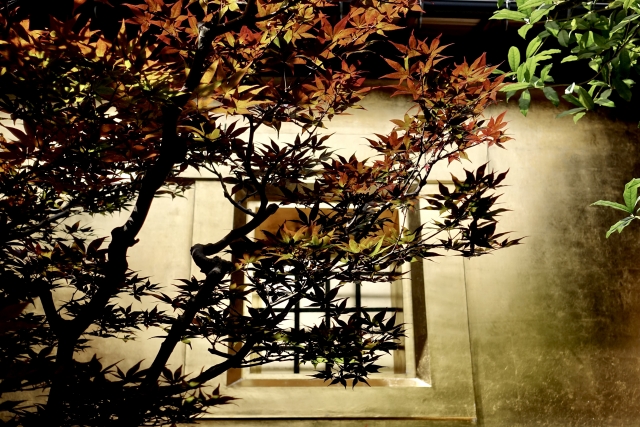
The following three companies are representative manufacturers of Kanazawa foil.
Imai Kinpaku Co.
Imai Kinpaku Co., Ltd. is a gold leaf manufacturer and wholesaler established in 1898.
Today, more than 100 years after its establishment, the company continues to produce high quality Kanazawa foil.
We are the only company in the industry that has built an integrated production system in-house, and we are passing on the techniques that have been handed down by skilled craftsmen to the next generation.
As part of this effort, we also offer a gold leaf application experience that conveys the appeal of Kanazawa leaf, providing an opportunity for everyone to experience gold leaf.
Foilichi Co.
Ltd. was founded in 1975 as a manufacturer and distributor of Kanazawa foil.
In addition to activities to carry on the tradition of Kanazawa foil, we are also actively engaged in the development of new technologies.
Another significant feature of the company is that it has incorporated the appeal of Kanazawa foil into a wide range of products, from crafts and furnishings to cosmetics, edible gold leaf, and architectural decorations, and has been promoting its potential to the rest of the world.
Gold and Silver Leaf Crafts Sakuda Co.
Ltd. was started in 1919 as a craftsman of Kanazawa foil.
Since then, the company has become widely known in the Buddhist altar and craft industry as a gold leaf distributor that handles a wide variety of gold leaf.
The company is also engaged in the production of its own traditional crafts, producing a wide variety of products ranging from gold leaf lacquerware to glass and fabric.
Summary
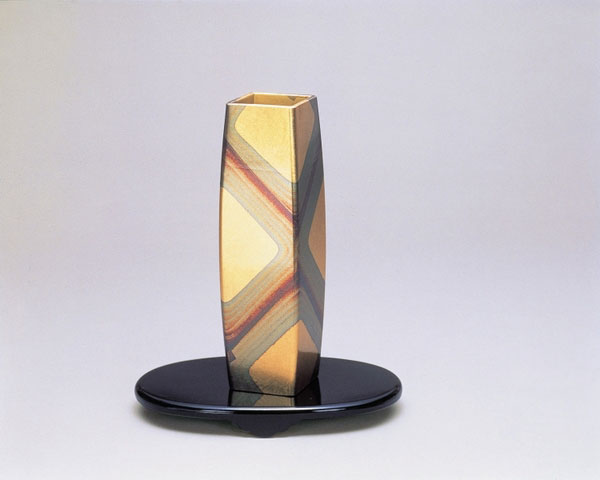
Kanazawa foil is one of Japan’s proudest traditional techniques.
Even when a ban on foiling was imposed more than 400 years ago, the technique was passed down through the dedicated efforts of craftsmen, and is still treasured today as a valuable asset.
The appeal of Kanazawa foil knows no bounds, and it is now incorporated into our daily lives in unexpected ways, such as in cooking, cosmetics, and items that add color to spaces.
The possibilities of Kanazawa foil will continue to blossom throughout the world.
Reference: [Official] Ishikawa Tourism/Travel Site “Hot Ishikawa Tabinet





